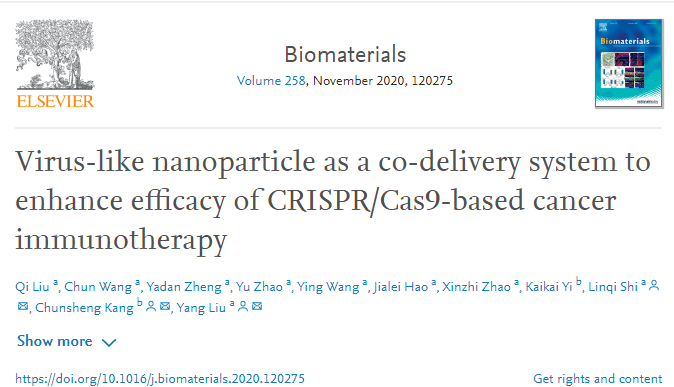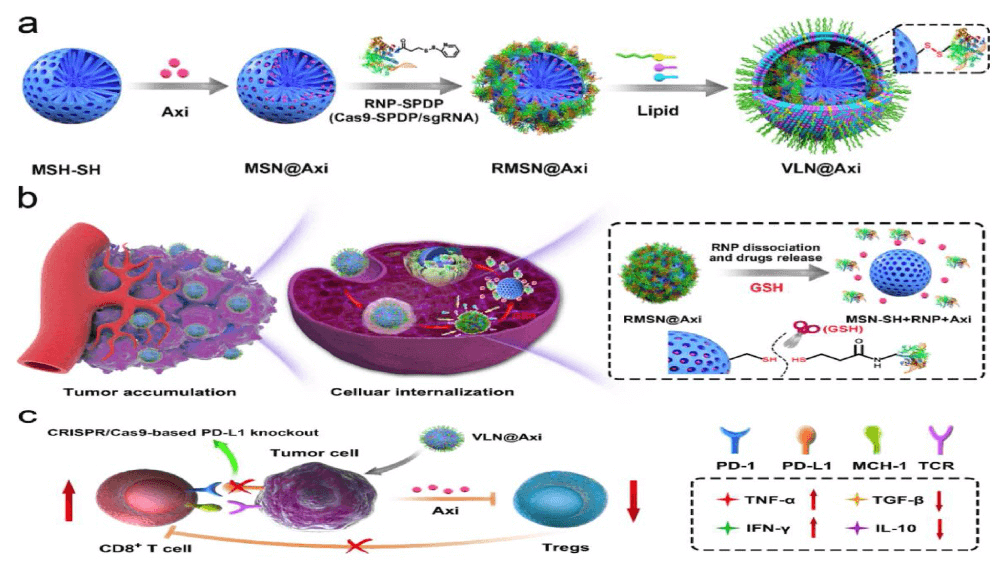Scientists from Professor Linqi Shi, Chunsheng Kang and Yang Liu’s group suggested that CRISPR/Cas9 system and small molecule drugs can be co-delivered by virus-like nanoparticle (VLN) for malignant cancer treatment. VLN can disrupt multiple immunosuppressive pathways and suppress the growth of melanoma by loading a single guide RNA (sgRNA) targeting PDL-1and Axitinib.
Fundamental Information
Title:Virus-like Nanoparticle as a Co-delivery System to Enhance Efficacy of CRISPR/Cas9-based Cancer Immunotherapy
Journal:Biomaterials
IF:10.273(2019)
Institution of the first author:Nankai University
Institution of the corresponding author:Nankai University,Tianjin Medical University General Hospital
Elabscience® Products Cited:
|
Cat. No |
Application |
Detection target |
Species |
Tested sample |
|
ELISA |
Mouse |
Tumor tissue |
||
|
ELISA |
Mouse |
Tumor tissue |
||
|
ELISA |
Mouse |
Tumor tissue |
||
|
ELISA |
Mouse |
Tumor tissue |

![]()

Background of the Research
Buildup of genetic shifts is the main cause of cancerous elements in the body. Due to these continuous changes in the genome, complex interactions take place in the tumor cells resulting in development of cancer. The signal networks provide a protective microenvironment for tumor development, which makes cancer treatment challenge. Recently developed CRISPR-Cas9 system can be used for precise gene editing which permanently damages the target genes and effectively treat cancer. Malignant tumors usually upregulate the expression of programmed death ligand 1 (PD-L1) to suppress T cell inflammatory activity through PD-1/PD-L1pathway. Disrupting PD-1/PD-L1 pathway with CRISPR/Cas9 system leads to the removal of this suppression, however, it is reported that checkpoint blockade immunotherapy targeting the PD-1/PD-L1 pathway is severely suppressed by abundance of immune suppressive cells, especially regulatory T cells (Tregs).
CRISPR/Cas9 systems and small molecule drugs are being studied these days to use their different combinations for cancer treatment, e.g. viral vectors. But these vectors have some integral defects like immunogenicity and scant loading capacity. So, viruses were not a good carrier for small molecule drugs. No long ago, advancement in drug delivery systems (DDS) provided new opportunities for the therapeutic applications of CRISPR systems. DDS including inorganic nanoparticles, polymer-based nanoparticles and lipid-based nanoparticles can simultaneously deliver Cas9 protein and single guide RNA (sgRNA) for CRISPR/Cas9-based cancer therapy. Hence, development of an all-inclusive approach for the co-delivery of CRISPR systems and small molecule drugs for the development of new cancer combination therapies is need of the hour.
Synthesis of VLN@Axi and delivery process after intravenous injection to revert the exhausted CD8+ T cells and suppression of Tregs

Research Findings and Innovations
1. Researchers demonstrated that CRISPR/CAS9 system and drugs having small molecules can be co-delivered through nanoplatform by using a virus-like nanoparticle for effective malignant cancer treatments.
2. They found out that VLN has a core-shell structure, which can carry small molecule drugs and CRISPR/Cas9 system in their MSN-based core, which is further encapsulated with a lipid layer containing PEG2000-DSPE. This structure protects RNP from enzymatic degradation and allows VLN to remain stable during blood circulation.
3. CRISPR/Cas9 system along with small drug molecule was released by VLN at tumor sites in a reductive microenvironment which results in synergistic regulation of multiple cancer-associated pathways.VLN revive T cells and decrease number of Tregs in TME by co-delivering Axi and sgRNA that targets PD-L1, ultimately inhibit the growth of melanoma.



